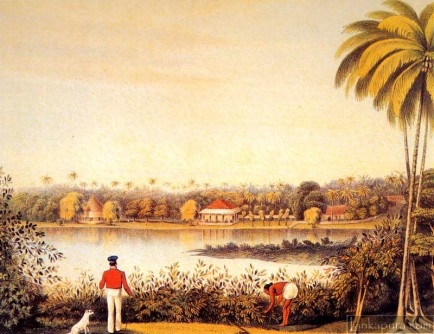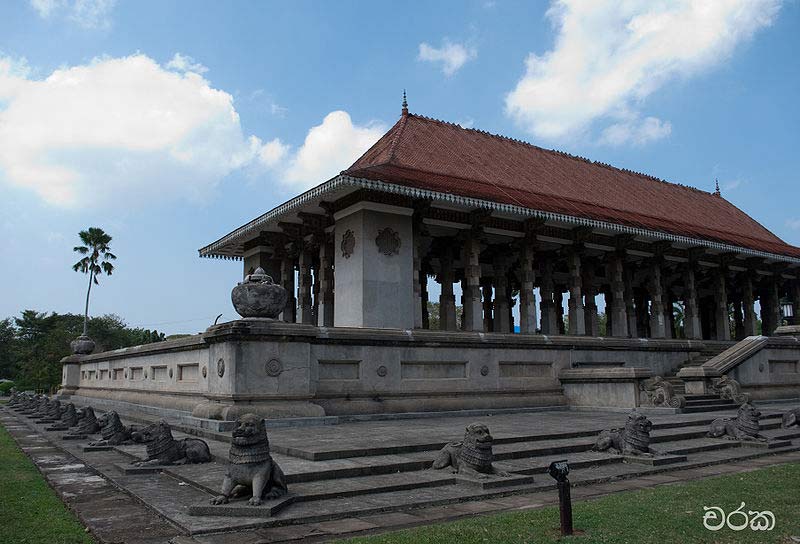
Cinnamon Gardens (Colombo-7) is a suburb in Colombo, Sri Lanka located three kilometres south-east from Colombo city centre. Cinnamon Gardens is named from the former cinnamon plantation in this area. In the year 1789, there were 289 acres (1.17 km2) of cinnamon trees in Cinnamon Gardens.
Nowadays Cinnamon Gardens is the location of the Prime Minister’s Office, Colombo Town Hall and National Museum as well as numerous foreign diplomatic missions. It is also the location of the Colombo Department of Meteorology and its observatory.
The cinnamon trade in Sri Lanka goes as far back to the time when Augustus Caesar ruled Rome. The Romans had communications with India, and it is said that they traded largely in cinnamon obtained from Sri Lanka.
Cinnamon Gardens & Cinnamon Trade in Sri Lanka
By Dr. K. D. Paranavitana

As a child, I travelled by rail with my grandmother from Hikkaduwa to Kollupitiya probably in 1957. Just outside the station were parked several red double-decker buses, strangely with the name, London Transport Board, and one of them carried us to our destination. It was somewhere on Gregory’s Road, which to my grandmother was Girigoris Para.
The journey was fantastic part by rail and part by double-decker. I was fascinated by the huge mansions, mostly one storey, with beautifully manicured gardens that we passed. My grandmother said the area was Kurundu Watta.
In 1964, when I joined the university, I found temporary lodging at Barnes Place. Then I had the opportunity of wandering along the streets of Kurundu Watta, although I did not know its history. Hundreds and thousands of people of all walks of life passing Kurundu Watta or Cinnamon Gardens even today pay no heed to its history. But what is the link between cinnamon and Cinnamon Gardens in Colombo?
Before that link is established one needs to look at the cinnamon trade in Sri Lanka, which goes as far back to the time when Augustus Caesar ruled Rome. The Romans had communications with India, and it is said that they traded largely in cinnamon obtained from Sri Lanka. The Arabs knew the value of cinnamon, but kept the trade a secret to maintain their monopoly. Pliny observed that cinnamon is a present fit for kings. Vasco de Gama knew that Sri Lanka had the finest cinnamon of the Indies. Dutch Governor Rijckloff van Goens Jr. (1675-80) stated cinnamon is said to be the bride around whom they dance in Ceylon
If not for cinnamon, the Portuguese, the Dutch and the British would not have taken such interest in this tiny island of Sri Lanka. The Portuguese and the Dutch captured the cinnamon monopoly from the Arabs.
Why was cinnamon of such value? Dr. C. G. Uragoda explains: Cinnamon has a delicate fragrance and a sweetly pungent taste. It is therefore used as a flavouring agent in confectionery, pharmaceutical preparations, chewing gums, toothpaste, mouth washes and inevitably in oriental curries. Cinnamon has carminative properties as well.

Cinnamon is the bark of the Cinnamomum Zelanicum tree. True cinnamon is a native of Sri Lanka and grows almost exclusively in this country. Sri Lanka holds the virtual monopoly of this product in the world market. True cinnamon has to be differentiated from Cassia, which is obtained from cinnamon cassia which grows in China.
The Portuguese and the Dutch both tolerated a lot from the Kandyan rulers, all for the love of cinnamon. An embassy was sent annually by the Dutch with much pomp and presents, both useful and not so useful, to seek formal leave to harvest cinnamon in the King’s territory, and a Dutch Governor wrote, If we do not continually, indeed nauseatingly, flatter and crave the court, we are at a disadvantage.
Earlier, in Portuguese times men left their homes to peel cinnamon in the thick jungle, which was considered a laborious and dangerous task. John Pybus wrote, The peelers had to deal with a number of elephants, wild buffaloes, tigers and other beasts with which the woods abound. Johan Jacob Saar observed that peeling in the jungle was in charge of 400 Sinhalese peelers and 25 soldiers with drummers who played all the time, occasionally musket shots being added to scare off the wild beasts. It costs the Dutch truly little in gold, but much in human blood.
Cinnamon was also cultivated in chenas, which was popular among Sinhalese cultivators who lived in the country’s interior. It was a kind of ‘shifting cultivation’ for, first the jungle had to be cleared and the ground made ready for plantation. A considerable area was burnt, cleared and planted with cinnamon. Several measures were taken over the years since 1705 to organise cinnamon cultivations following the chena method.
A proclamation on October 8, 1745 imposed a fine of 10 riks dollars for illegal cutting per tree from one to 50 trees. Those who got caught, but did not pay, were chained and jailed for five to 10 years. Removing a cinnamon tree from its root would be even worse, with the fine being doubled. In certain instances, culprits were banished to the Cape of Good Hope.
For some inexplicable reason, the high-ranking administrators of the Portuguese and the Dutch were from the very beginning of the opinion that cinnamon could not be cultivated, that it would only grow wild. This view changed after more than a century of Dutch rule, when high officials, including the Disave, realised it could grow in gardens. This made the Dutch less dependent on the king’s whims.
The first garden was cultivated in Colombo at Maradana, and the Dutch term for it was tuin, meaning sandy plain. Cinnamon loves poor soil. A cinnamon tree would mature in five years in sandy soil and in seven years in good soil. Following Maradana’s success, several gardens were established in Negombo, Kalutara, Galle and Matara, and the Sinhalese were encouraged to start small ones in their own areas. Regulations were issued from time to time against private dealing in cinnamon, which was even punishable by death. Destruction of plants also carried the death penalty in Maradana, and a whipping elsewhere.
On October 15, 1785, a Lutheran minister, Jan Brandes visited the cinnamon garden in Maradana as a guest of the Disave of Colombo, Cornelis de Cock, the proprietor of the garden, just six days after his arrival in Colombo. Although the Disave was a high ranking officer of the Dutch East India Company, he considered the maintenance of this cinnamon garden his principal task. He was responsible for laying out the cinnamon garden in Colombo in 1789 on the orders of Governor Iman Wilem Falck (1765-85). This garden belonging to Disave Cock totalled 116 amunas, equivalent to about 232 acres. He employed 150 natives and also put up a wooden fence around it to keep out the cattle and other animal’s that could destroy the plantation. Disave Cock was the largest private owner of cinnamon gardens, including Maradana.
On a subsequent visit to the cinnamon garden in Maradana, Brandes produced a beautiful watercolour drawing, showing the entrance to the garden with a number of local employees who were busy peeling cinnamon, and also the temporary sheds constructed for the purpose. In the foreground, the Disave appears to be in conversation with two women.
This sort of cinnamon plantations were required to give a continuous supply of cinnamon without depending on the territory under the king. Another aim was to overcome a severe drop in the supply after the rebellion of 1757-60, followed by large-scale war in 1761. According to the description of Jan Brandes in 1786 the garden stretched up to the Beira Lake on the west, and from there several kilometres to the south around Bambalapitiya. Its inland border extended up to the boundary of the former kingdom of Kotte.
In early British times, it was Governor Frederick North who took a keen interest in the cinnamon garden established by the Dutch. He suggested that all the cinnamon requirements of the British could be met with the produce from this garden. After him, as the British administration was heading for war with Kandy, which ended in the British conquering the whole island in 1815 and until the establishment of the Legislative Council in 1833, hardly any attention was paid to the cinnamon plantation at Maradana. The ravages of time ensured that Maradana’s cinnamon garden was covered with natural vegetation, and a section of it where the present SLBC is located came to be known as Kumbi Kele.
Later, with the shifting of the Racecourse of the Ceylon Turf Club from Galle Face to this cinnamon garden in the 1850s, the area gained a reputation as being much-sought after by the rich and powerful, who wished to establish their stately homes here. But in the 1840’s only a few wanted to invest in the cinnamon industry as coffee yielded higher profits.
Sadly, cinnamon never recovered the mighty position it had enjoyed in the years before the Colebrooke Cameron reforms in 1833, and dropped into the category of minor crops in the island. It also ended the heyday of the Dutch cinnamon garden in Colombo, which however, retains the name Cinnamon Gardens, now an area without a single cinnamon tree.
Courtesy: LankaNewspapers.com
